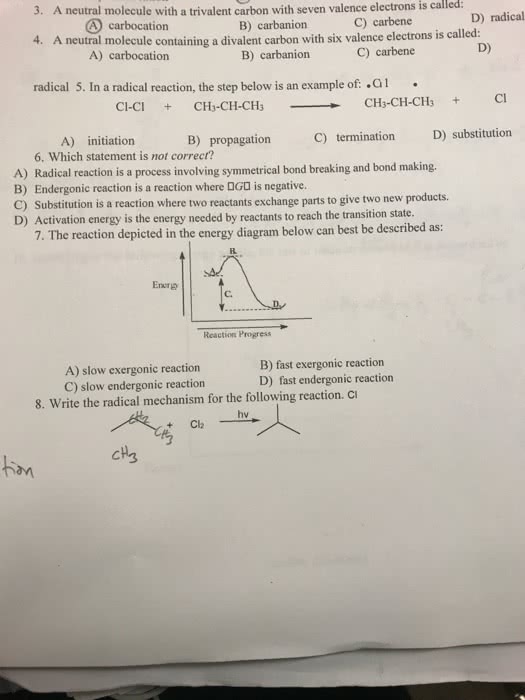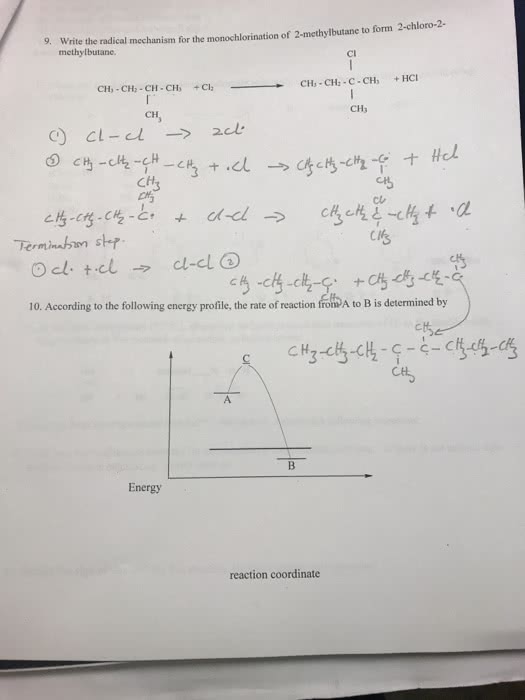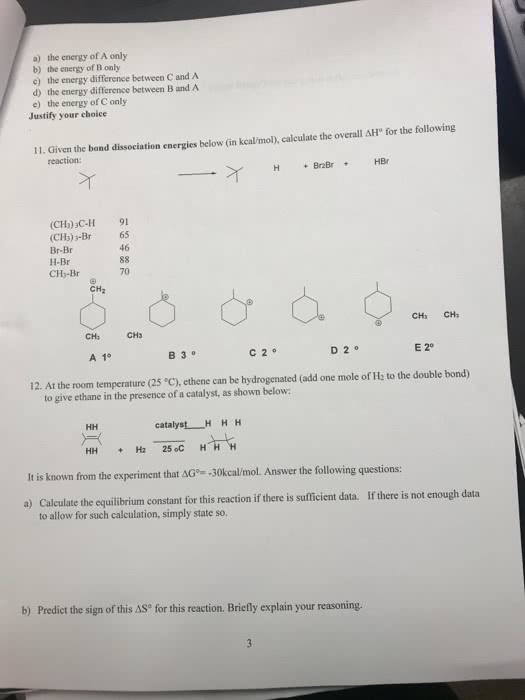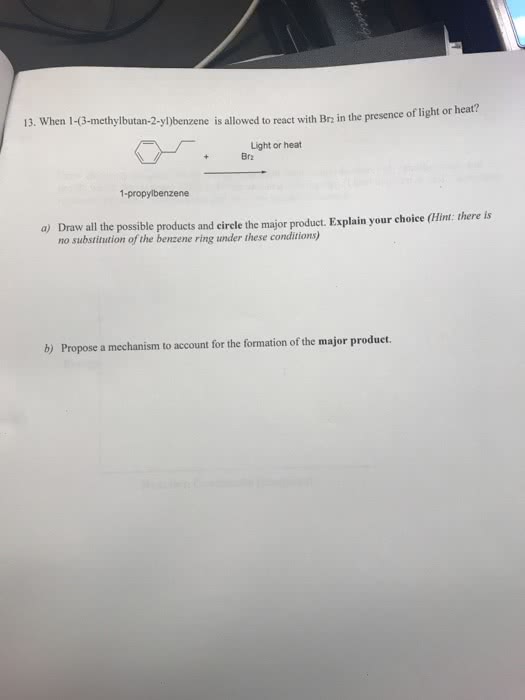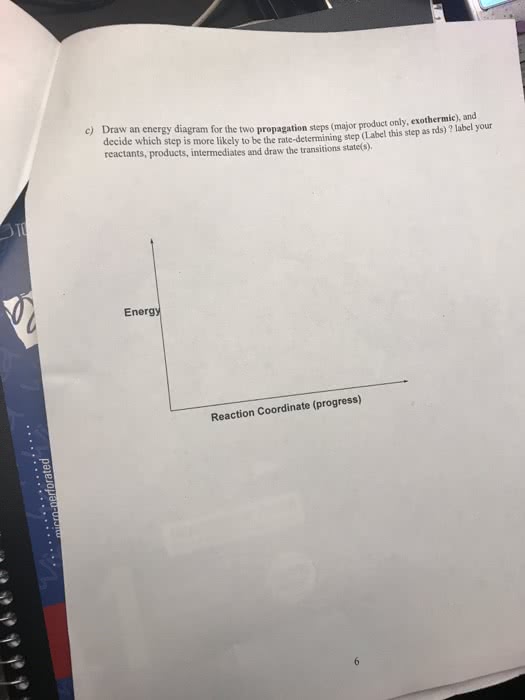1.When something appears blue, it is absorbing all colors except__________.
yellow
blue
red
green
orange
2.During heavy exercise, lactic acid can build up in ourmuscles. Why? How does this resemble the metabolism of bacteria andyeast?
lactic acid is results from insufficient oxygen during sugarmetabolism; it is fermentation
lactic acid accumulates when we are dehydrated; bacteria andyeast use the same pathway
lactic acid is built up from carbon dioxide; bacteria and yeaststore energy in this way
3.Why must a cell keep a similar concentration of dissolvedsubstances with the fluid surrounding them?
to avoid dilution of potential energy
to avoid osmotic imbalance and rapid gain or loss of water
to maintain the correct amount of dehydration and hydrolysis
4.What is entropy?
the amount of energy in a system
the amount of disorganization
the amount of organization
5.Burning a log is the reverse reaction found in photosynthesis.What products would be formed in burning a log?
carbon dioxide and water
glucose and oxygen
oxygen and carbon dioxide
oxygen and water
6.The main reason that cellular respiration needs to occur stepby step instead of a single, big reaction is
cells don't store enough oxygen
too much energy would be released for the cell to harness
cells don't have many mitochondria.
cells produce the enzymes needed for cellular respiration veryslowly
7.Enzymes are catalysts because they operate to:
raise activation energy
lower activation energy
supply activation energy
supply the reactants
8.When ATP powers a reaction it becomes ADP. The ADP
can reform ATP by an exergonic reaction
is a waste product for lysosomal breakdown
can reform ATP by an endergonic reaction
can reform ATP by an oxidation reaction
can reform ATP by an equilibrium reaction
9.The energy source that drives photosynthesis is
water
glucose
carbon dioxide
oxygen
sunlight
10. What is the process by which enzymes regulate their ownactivity?
osmosis
self-propulsion
feedback inhibition
11.Coupled reactions are reactions in which a
endergonic reaction drives a spontaneous reaction
exergonic reaction drives a spontaneous reaction
endergonic reaction drives an exergonic reaction
exergonic reaction drives an endergonic reaction
12.How is water used in photosynthesis?
as a substrate for ATP synthase
as an electron donor
to combine with ADP forming ATP
as an electron acceptor
13.Why are the âDark Reactionsâ of photosynthesis referred to asâDarkâ?
they do not require light
they can only occur at night
they generate excess sugar and the leaves turn brown
14.What is the difference between potential and kineticenergy?
potential is stored, kinetic is being used
potential is being used, kinetic is ready to be used
potential is negative, kinetic is positive
15.The products of cellular respiration are
carbon dioxide, water, and ATP
glucose, water, and ATP
glucose, carbon dioxide, and ATP
oxygen, ATP, and water
carbon dioxide, glucose, and water
16.All of the following are correct about energy except:
The biological world gets its energy from the sun.
Chemical bonds store potential energy.
A boulder perched on a hill has kinetic energy.
Energy is defined as the ability to do work.
All forms of energy can be converted to heat.
17.What is needed for the end product of glycolysis, pyruvate,to enter the citric acid cycle?
More glucose for energy
ATP
Oxygen
Carbon dioxide
18.The enzyme that forms a transmembrane channel in mitochondriaand phosphorylates ADP
a carrier protein
ATP synthase
acetyl CoA
19.Fermentation is most common in
plants
microorganisms
animals
20.During adsorption of sunlight by photosystems, H+ ions aregenerated. Where do they come from? What are they used for?
from the breakdown of sugar; they help form water
water; they help form sugar
from carbon dioxide; they help dissolve NaCl
21.Glycolysis
does not use oxygen
uses oxygen
uses carbon dioxide
22.Photosynthesis is
not dependent on chlorophyll
a process that produces glucose and oxygen
a process that produces water and carbon dioxide
23.Breakdown of glucose generates many ATP molecules, each ofwhich can be used independently. Why is ATP ideally suited to powerbiological reactions?
ATP has many hydrogen bonds
ATP has enough energy to power one biological reaction
ATP readily dissolves in water
24.Objects that are not actively moving but have the capacity todo so are said to possess:
kinetic energy
entropy
potential energy
living energy
25.The first stage of cellular respiration, called ___________,takes place in the cytoplasm of the cell and needs no oxygen.
photorespiration
citric acid cycle
glycolysis
oxidation
26.Diffusion
requires energy
utilizes proteins to move molecules across a membrane
moves molecules against a concentration gradient
does not require energy
cannot occur without a membrane present
27.What is the name of the molecule on which an enzymeworks?
substrate
monomer
polymer
28.ATP contains
phenylalanine
two phosphate groups
three nitrate groups
three phosphate groups
29.How does chlorophyll function in photosynthesis?
by absorbing carbon dioxide
by absorbing the sun's energy
by absorbing water
30.Objects that are moving are said to possess:
living energy
potential energy
entropy
kinetic energy
31.The respiration pathway that evolved first is probably
glycolysis
aerobic respiration
citric acid cycle
32.The energy source for the process of photosynthesis is
oxygen
sunlight
carbon dioxide
chlorophyll
glucose
33.Burning wood generates heat and light. What type of reactionis this?
exergonic
kinetic energy
endergonic
potential energy
equilibrium
34.What is meant by a âcoupled reactionâ in terms of energy?
many poymers are built simultaneously
energy released by one reactions powers another reaction
some reactions occur in the same organelle
35.The First Law of Thermodynamics states:
energy is constantly being created by entropy events
energy can be changed from one form to another, but cannot becreated or destroyed
energy can be used and then destroyed because of entropy'sactions on it
energy can be destroyed while it is producing entropy
36.How do we dispose of the carbon derived from the glucose thatis metabolized during respiration?
by breathing out
via our urine
it is broken down in lysosomes
37.Both plant and animal cells have mitochondria because theyboth
carry on respiration
carry on photosynthesis.
require water
38.What is Activation Energy?
the energy needed to initiate a reaction
the energy that transports water into cells
potential energy
39.If you put a plant in a chamber and shine a light on it
oxygen will decrease and carbon dioxide will increase
oxygen will increase and carbon dioxide will decrease
oxygen and carbon dioxide will increase
oxygen and carbon dioxide will decrease
40.What are the inputs and the output molecules for the overallphotosynthetic process?
input sugar and oxygen; output carbon dioxide and water
input oxygen and water; output sugar and carbon dioxide
input carbon dioxide and water;output sugar and oxygen
41.What kind of reaction is photosynthesis?
endergonic
kinetic energy
exergonic
potential energy
equilibrium
42.In the process of glycolysis, glucose is cleaved into a pairof three-carbon molecules called
lactate
pyruvate
acetyl CoA
ATP
alcohol
43.Entropy is
order
disorder
complexity
Both order and disorder are correct
Both complexity and disorder are correct
44.Glycolysis takes place in the _____________ and the citricacid cycle and electron transport chain take place in the___________.
cytoplasm; endoplasmic reticulum
mitochondria, chloroplast
mitochondria; cytoplasm
cytoplasm; mitochondria
45.The organelle that carries out photosynthesis in plants isthe
mitochondria
chloroplast
ribosome
chlorophylllysosome
46.The energy to power the Calvin cycle comes from
cellular respiration
oxygen
the light reactions of photosynthesis
47.Which of the following can be broken down into intermediateproducts that enter cellular respiration?
Proteins
Lipids
Carbohydrates
All of these.
48.When cellular product levels get too high, the responsibleenzyme is inhibited. This is an example of
promotion
denaturation
equilibrium
a coenzyme
feedback inhibition
49.How is respiration the opposite of photosynthesis?
respiration breaks sugar down to carbon dioxide; photosynthesisbuilds sugar from carbon dioxide
respiration builds sugar from carbon dioxide; photosynthesisbreaks sugar down to carbon dioxide
respiration requires energy input; photosynthesis gives offexcess energy
50.The molecule that absorbs sunlight for photosynthesis is
oxygen
carbon dioxide
chlorophyll
glucose
sunlight


